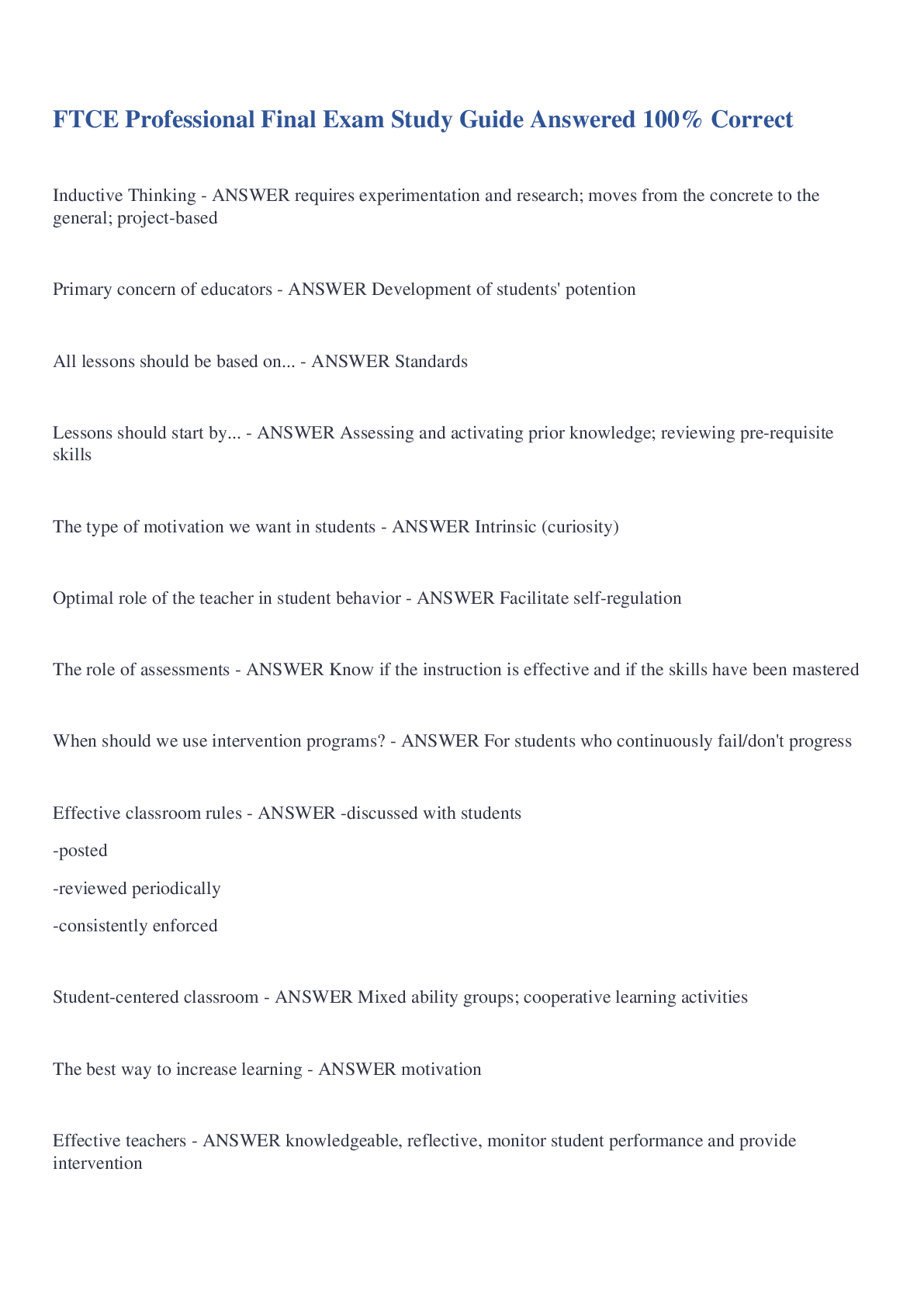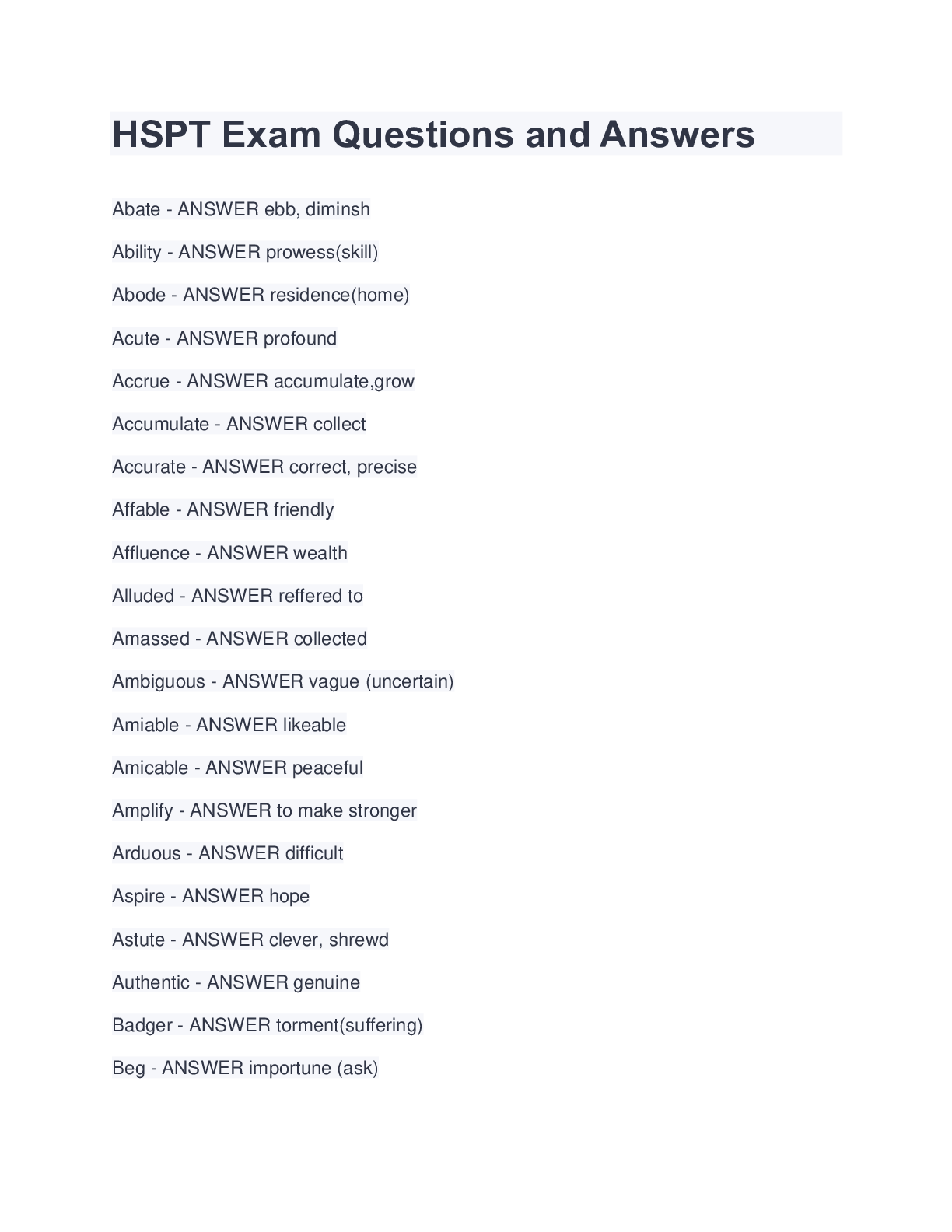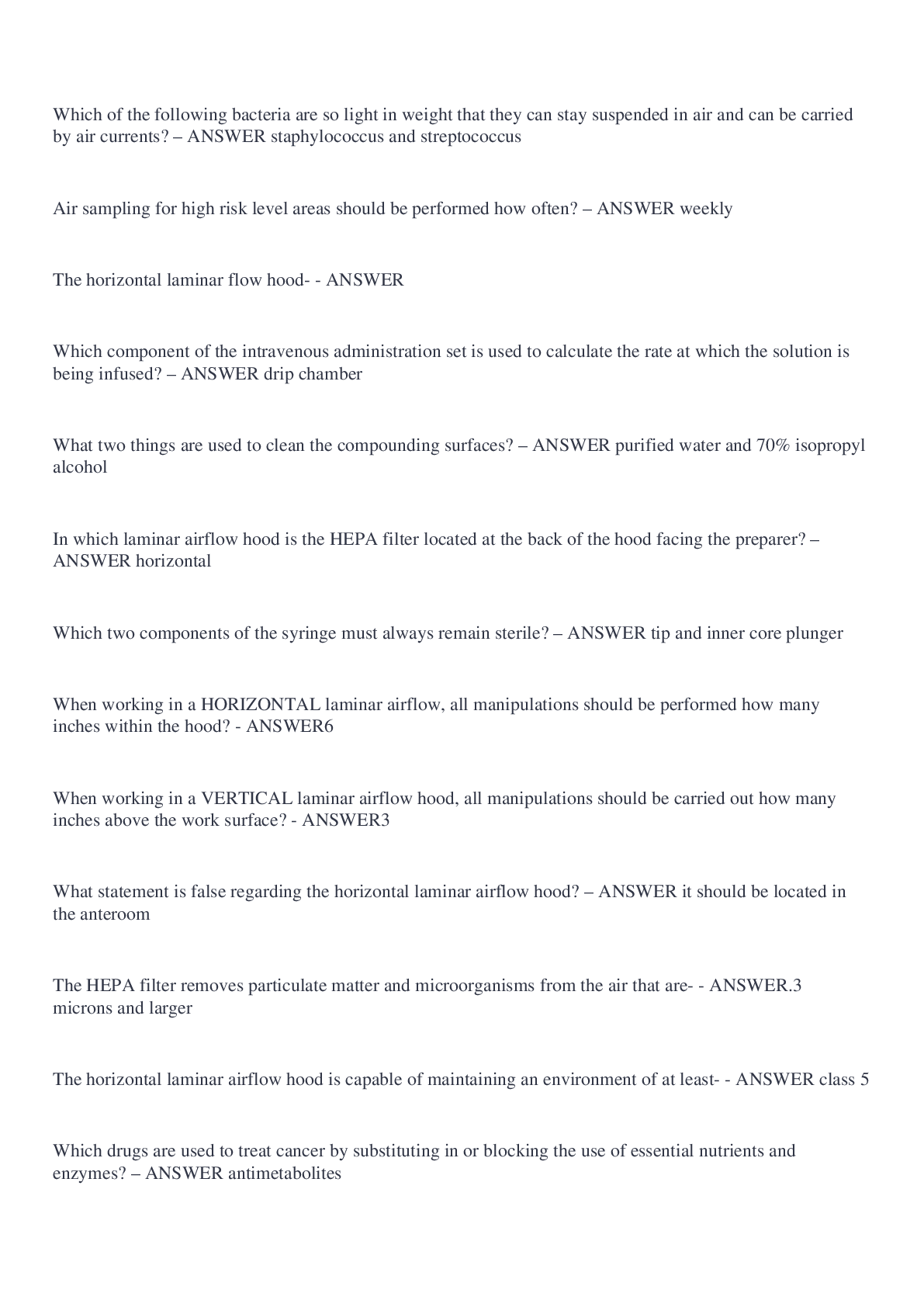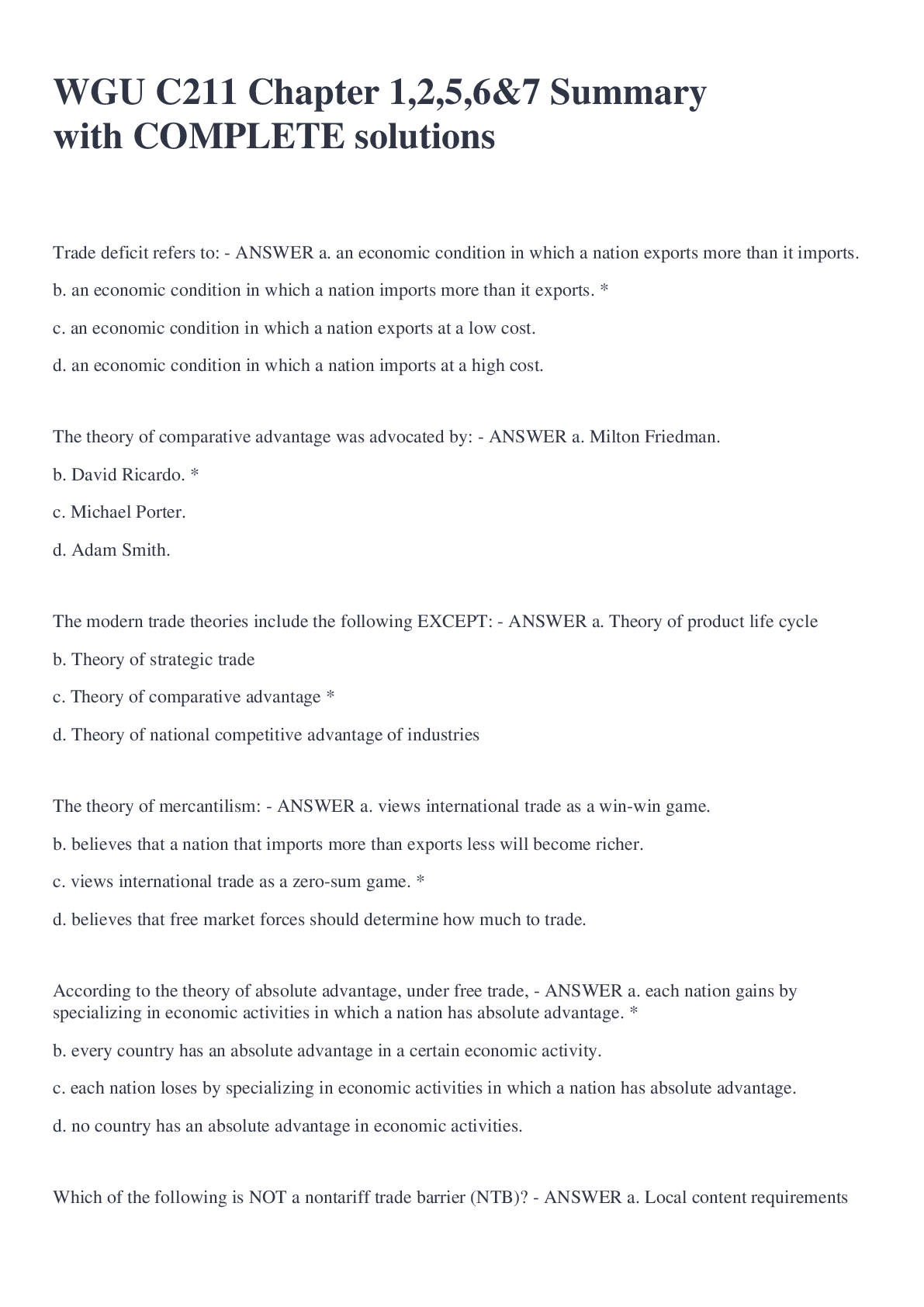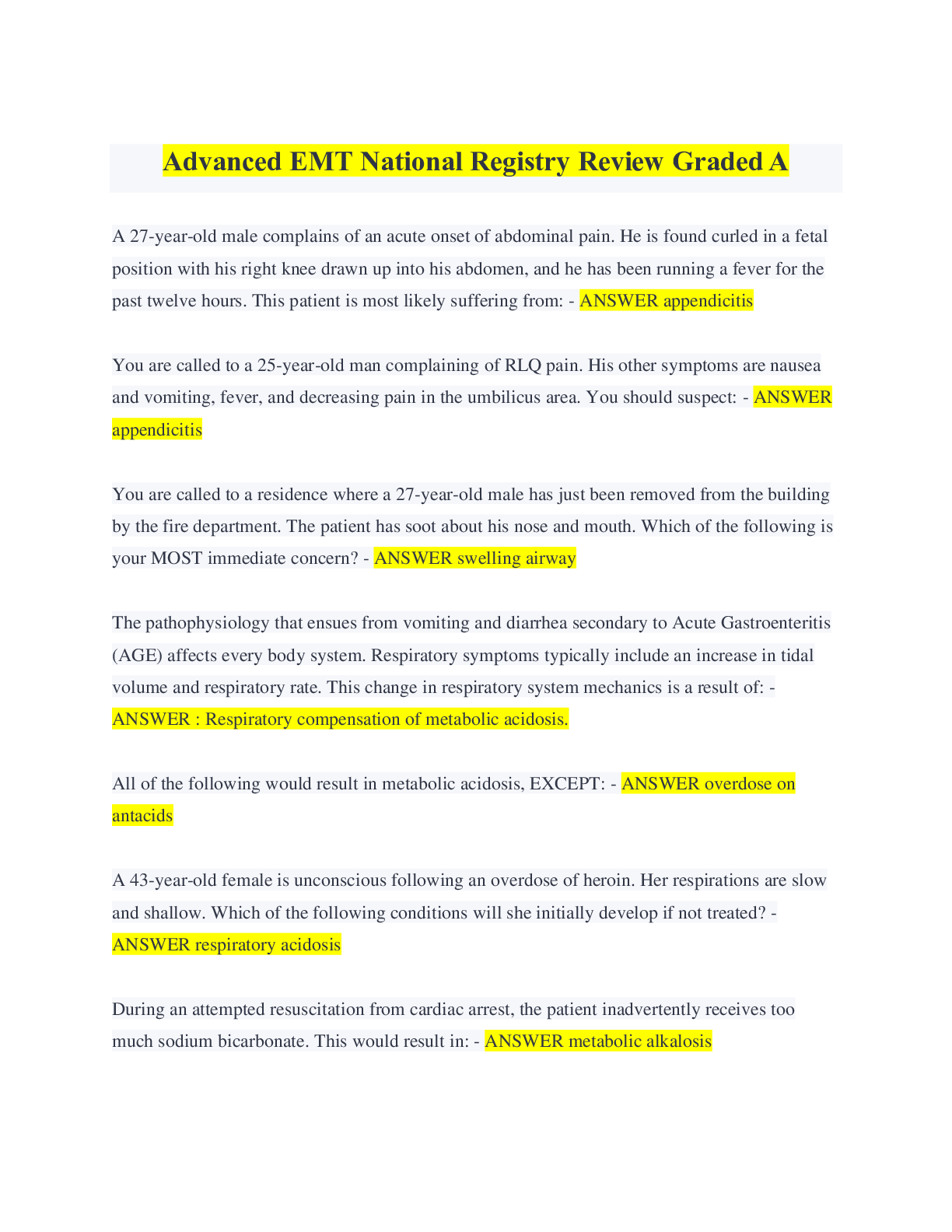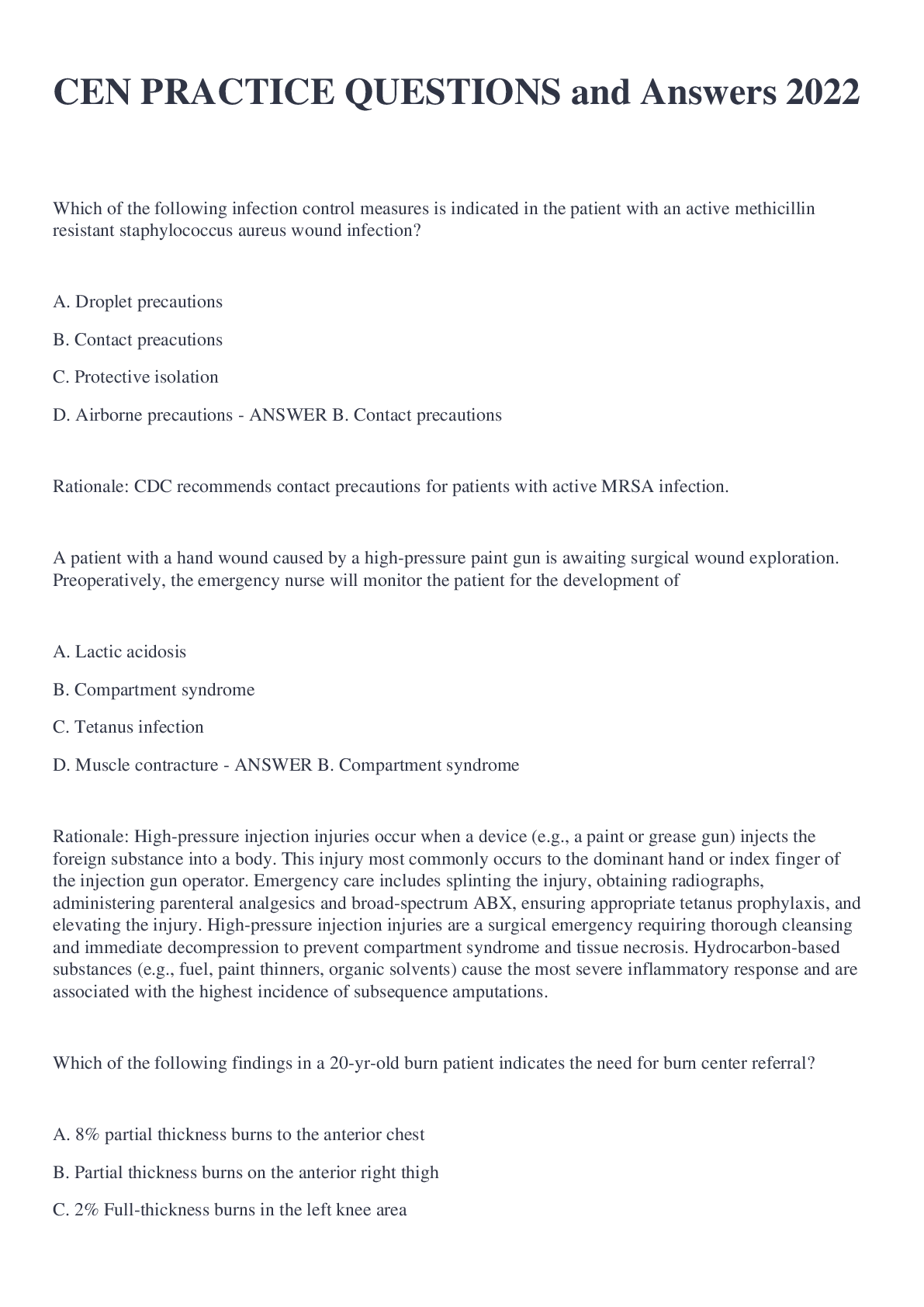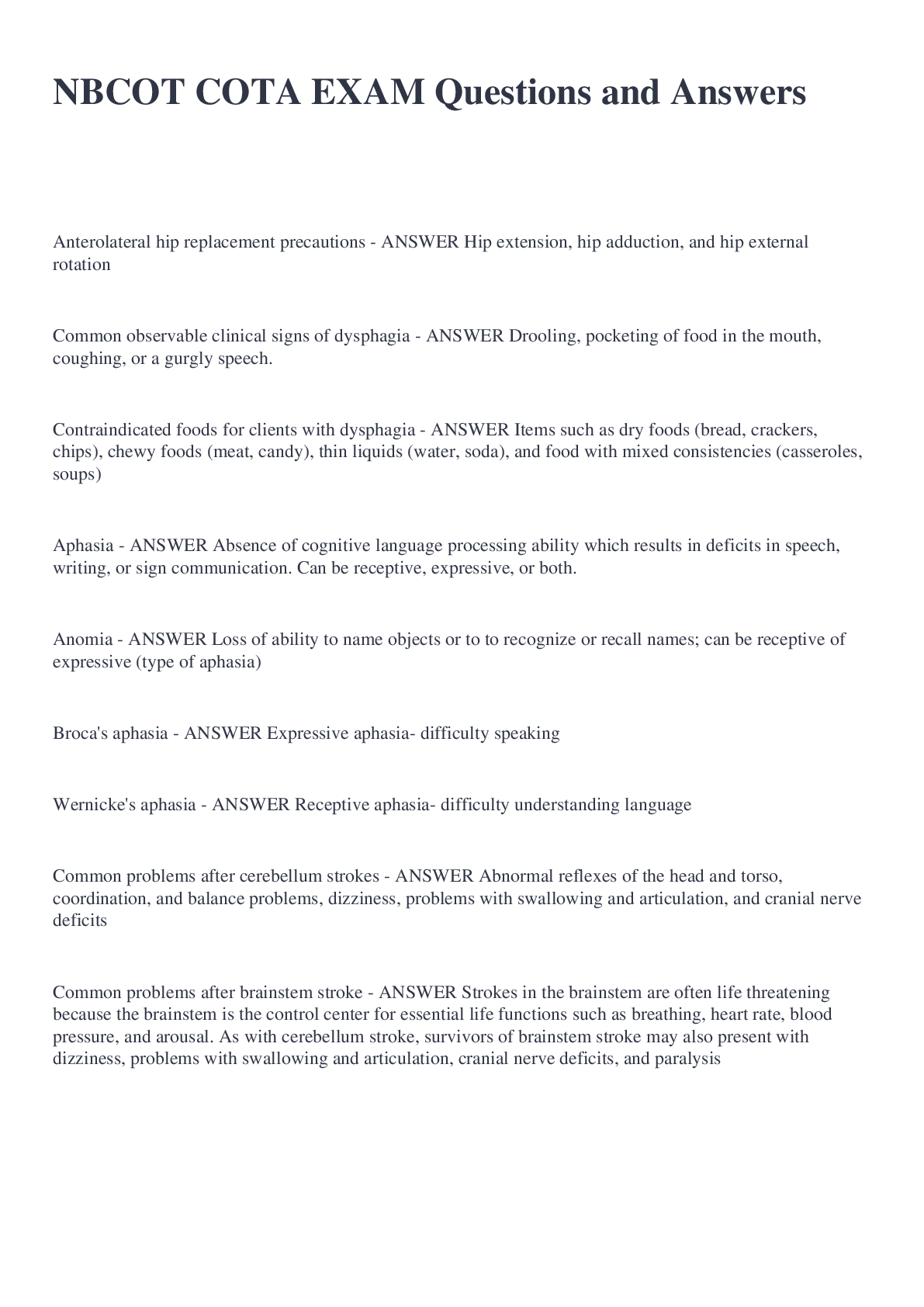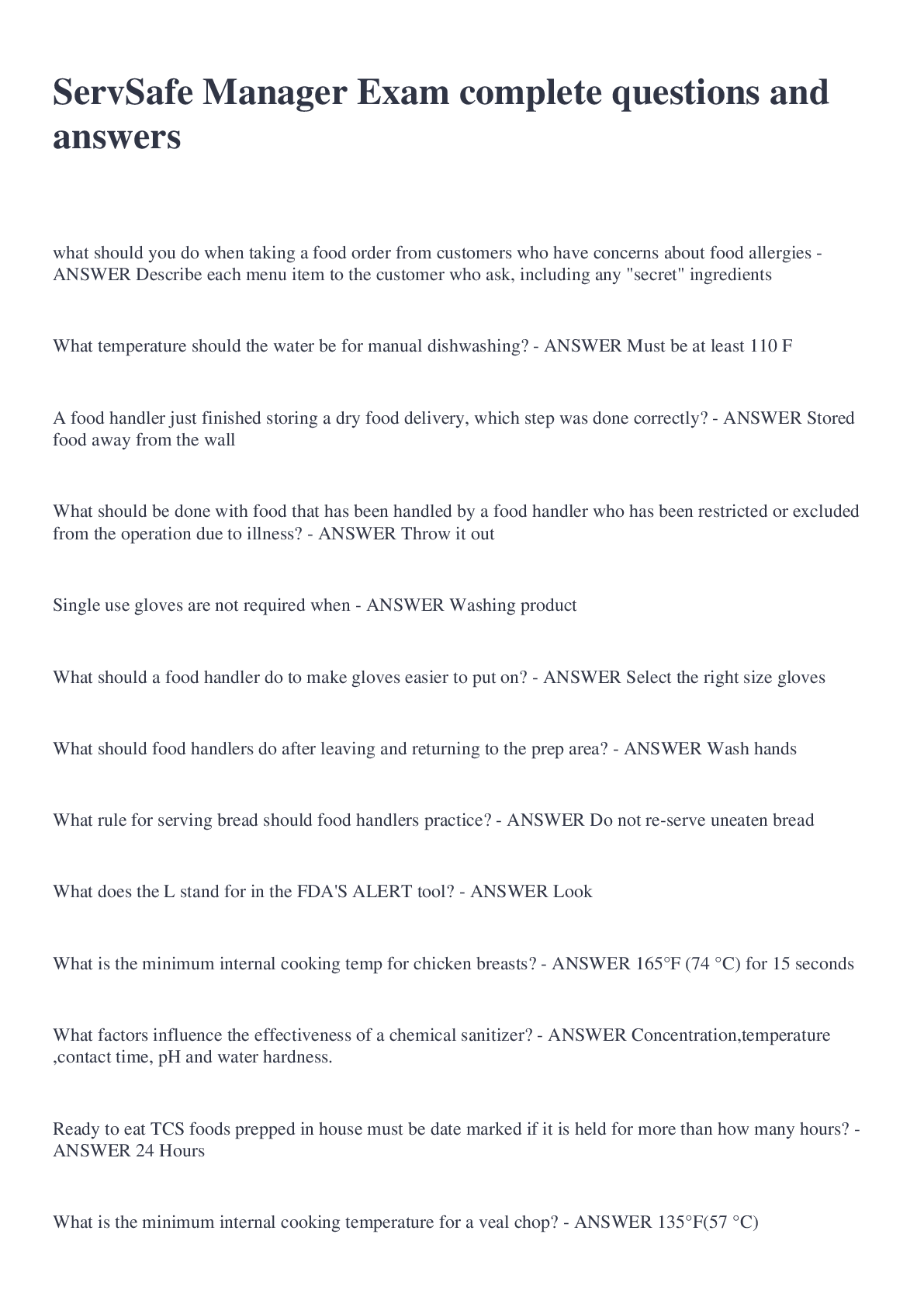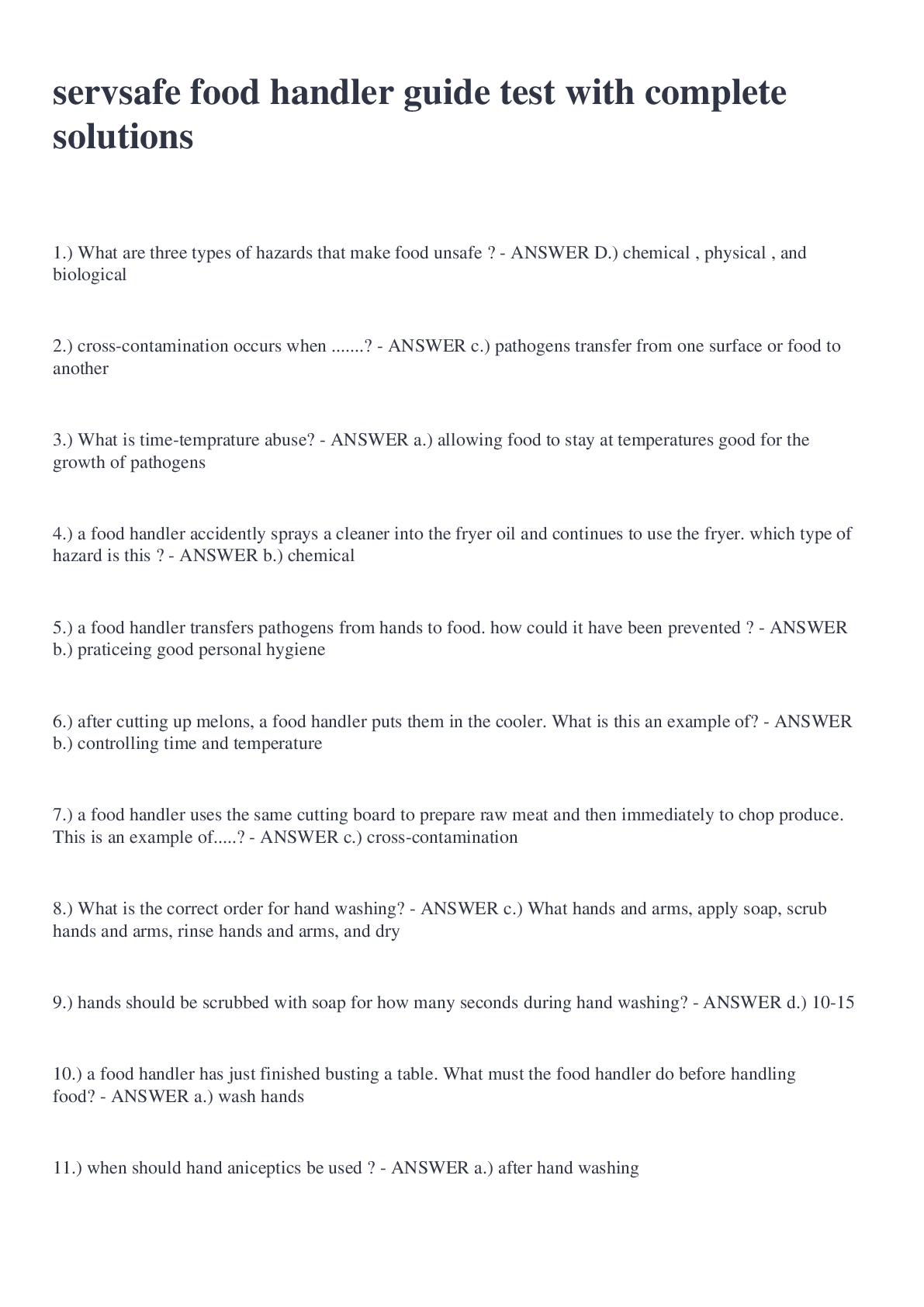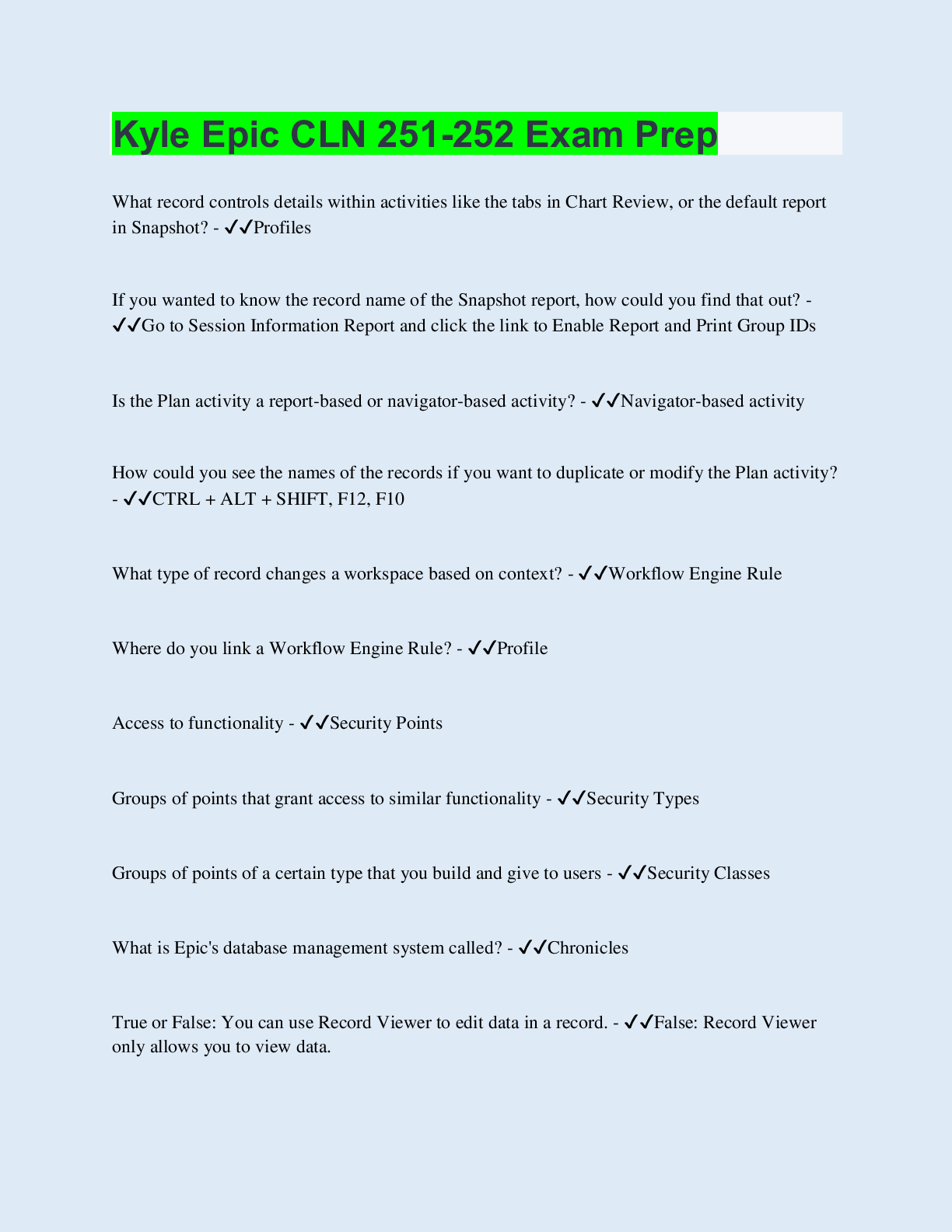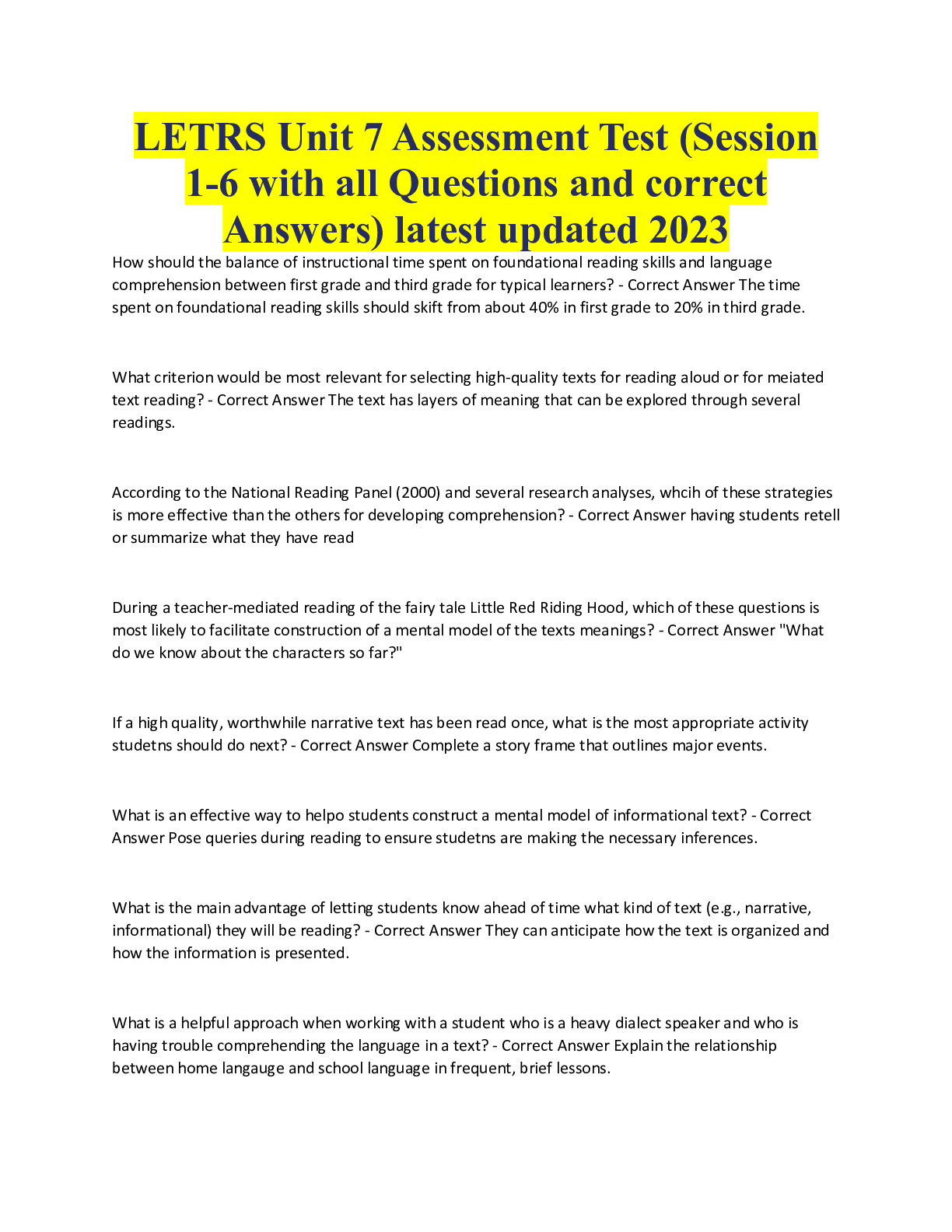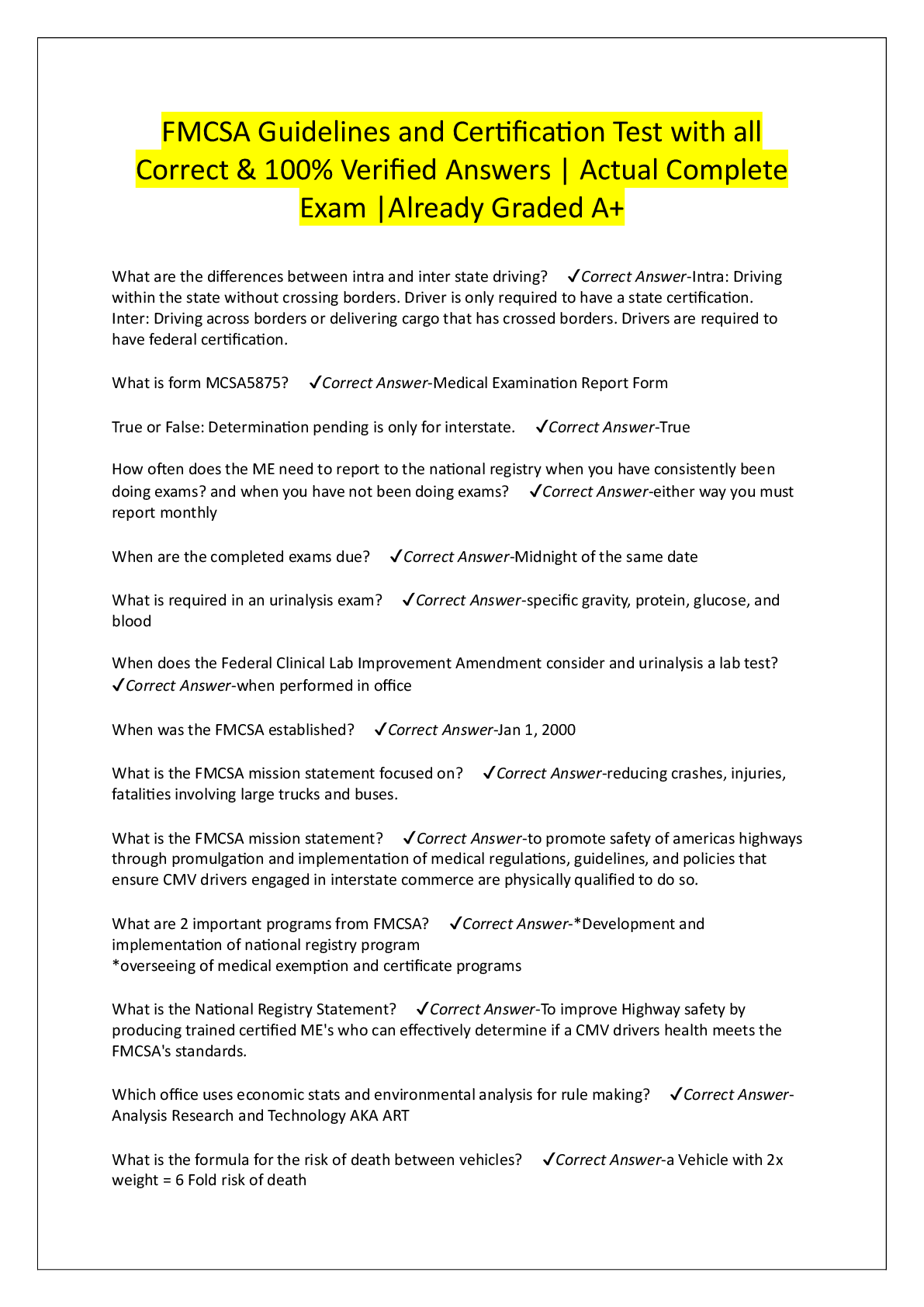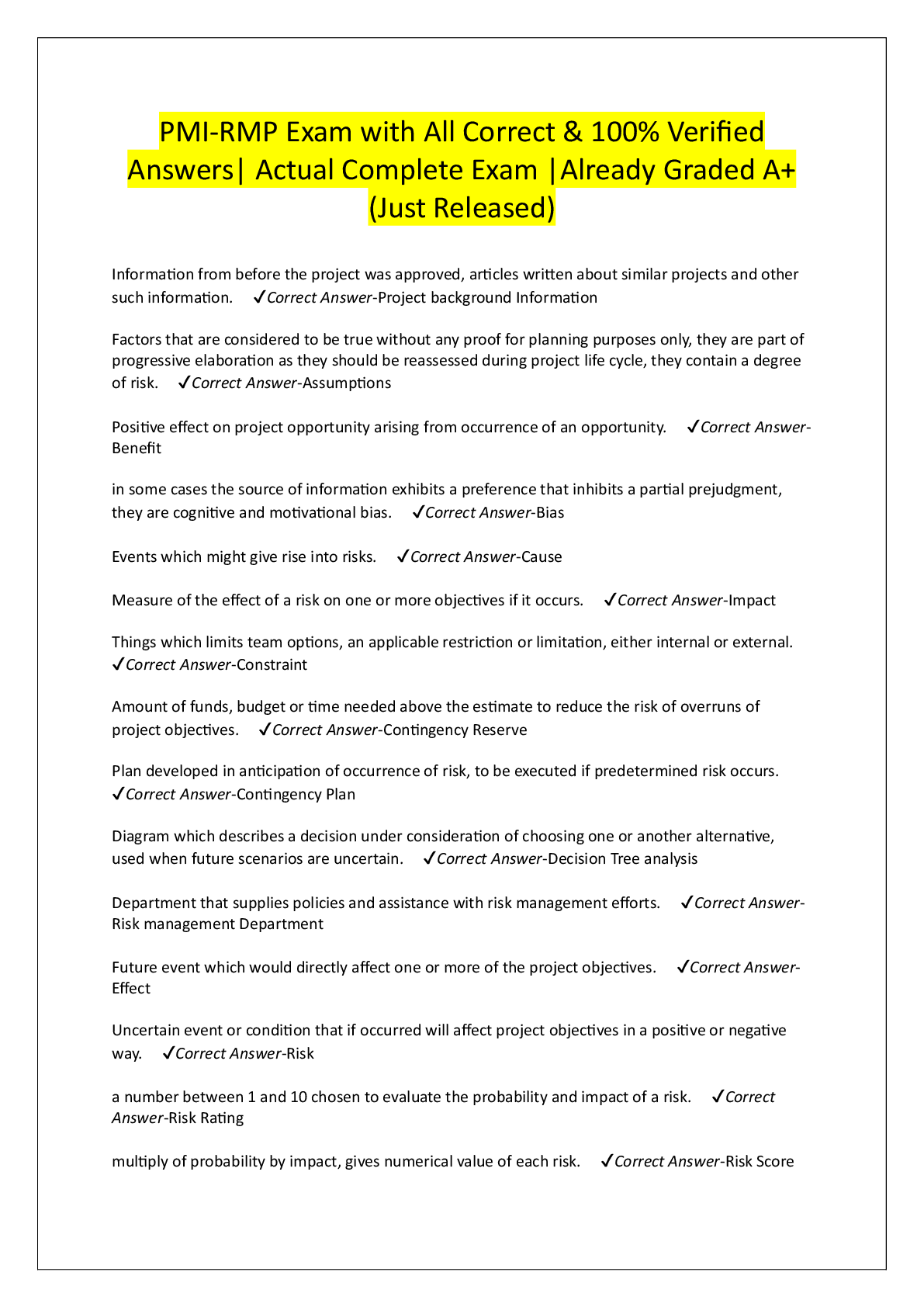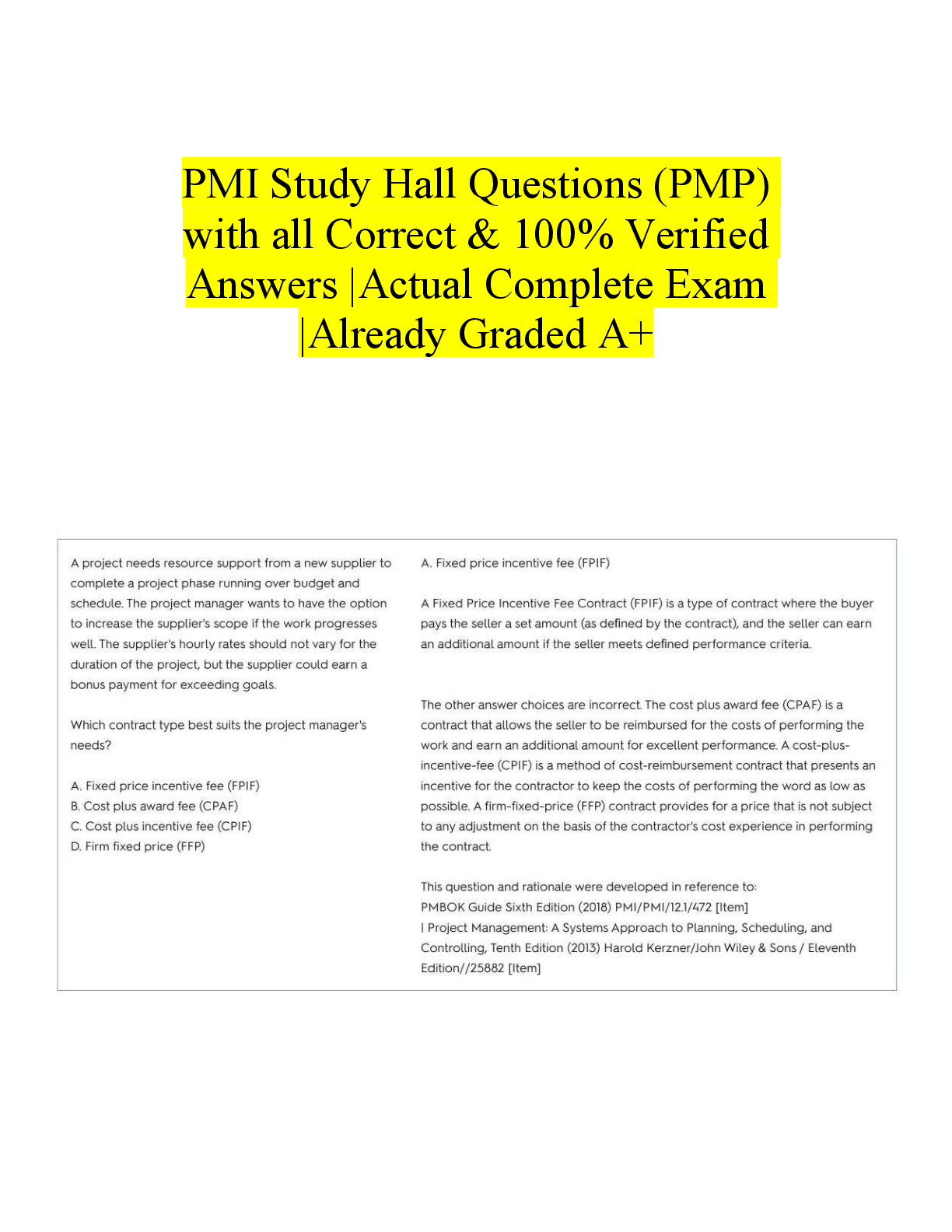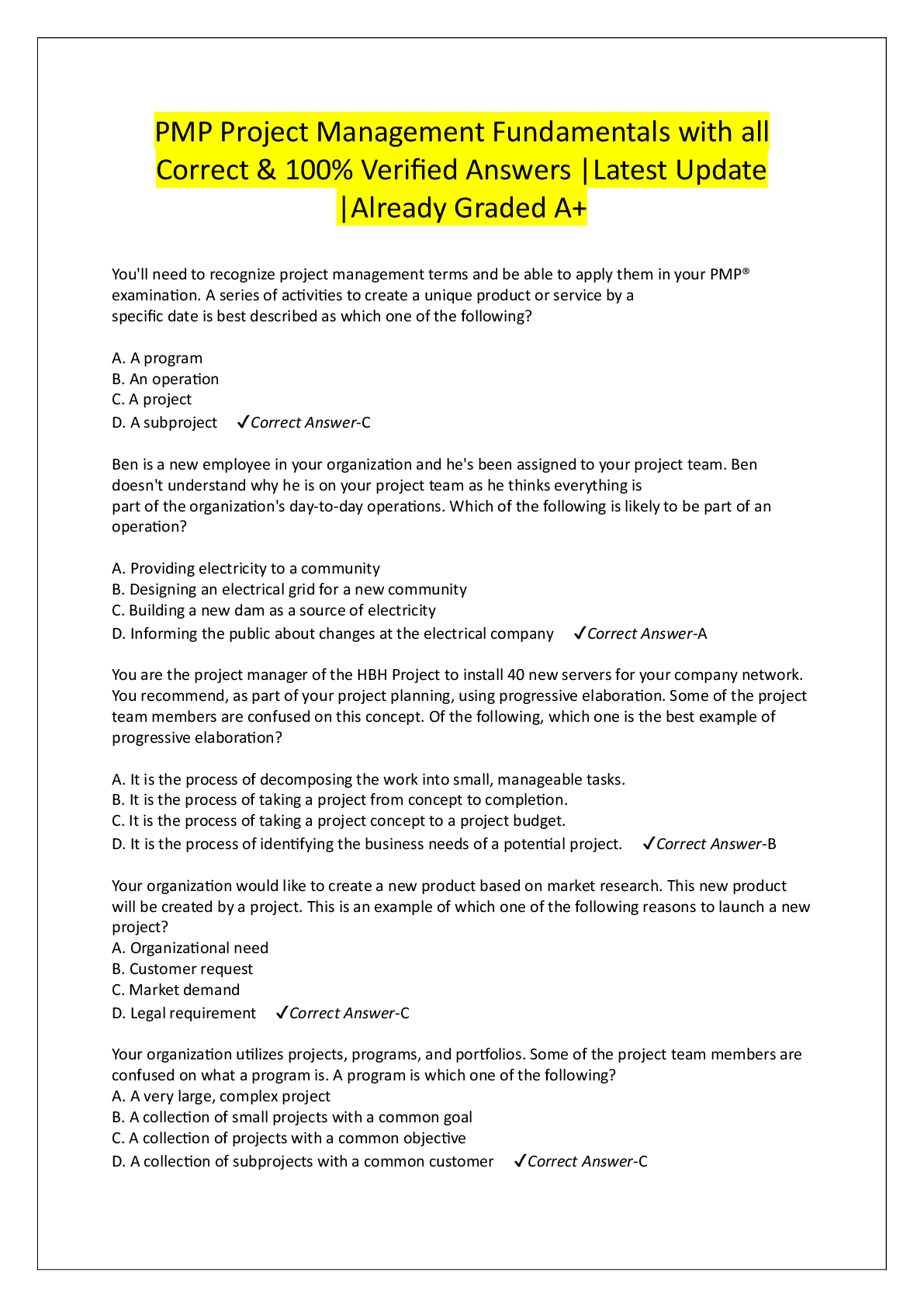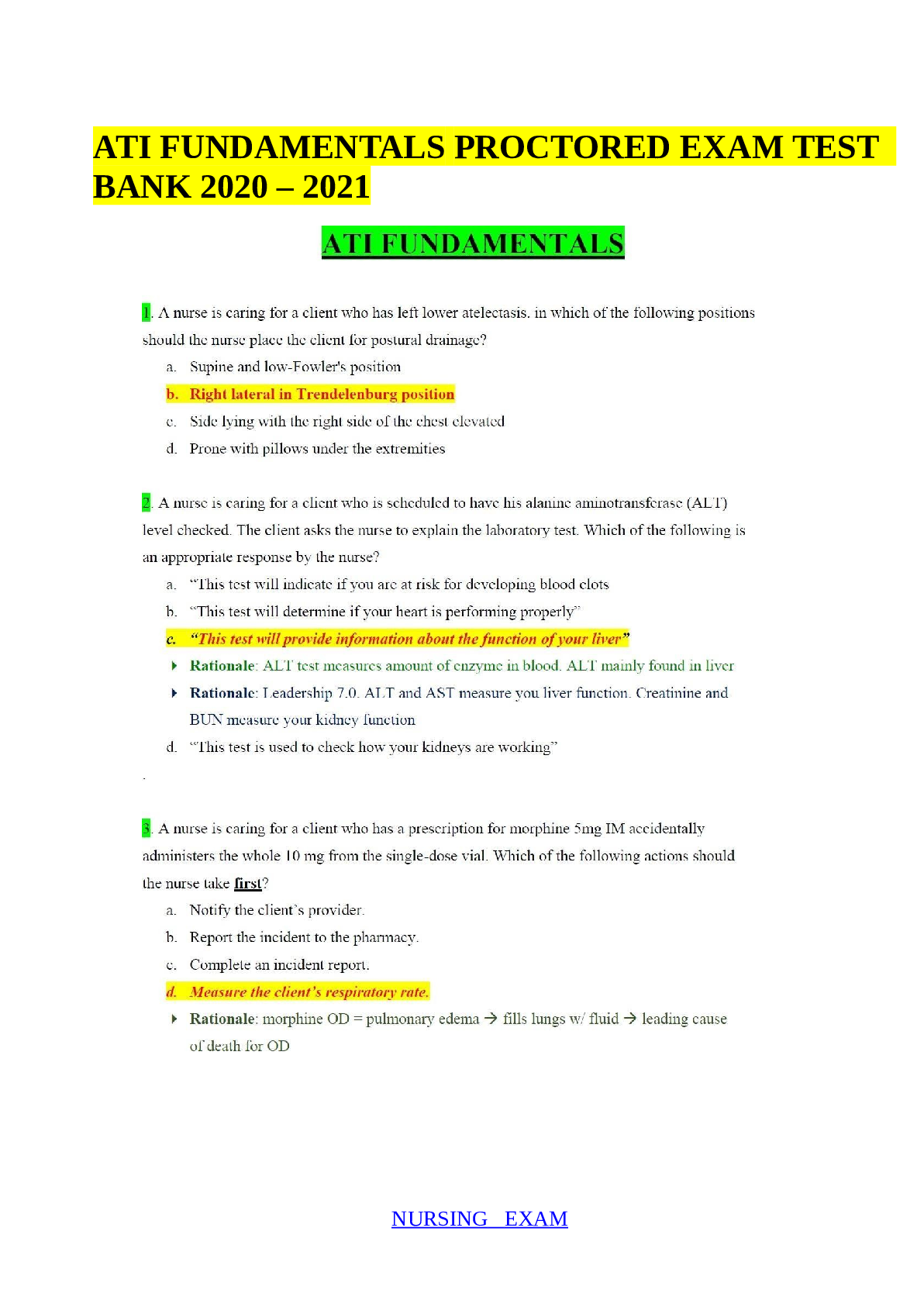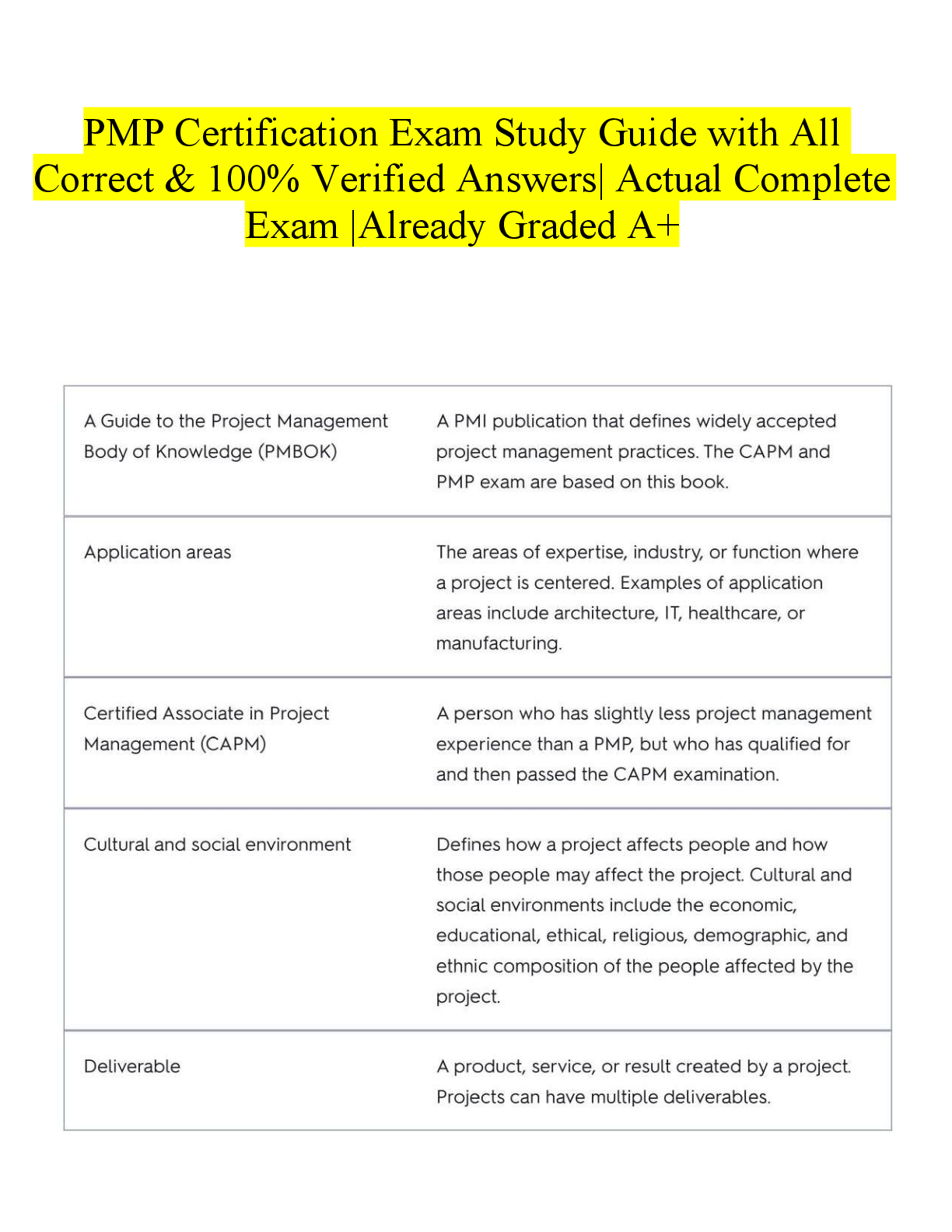Paediatrics > EXAM > Pediatrics Exam1- Practice Questions and Answers Latest Updated (All)
Pediatrics Exam1- Practice Questions and Answers Latest Updated
Document Content and Description Below
A nurse is conducting an admission interview with the mother of a 2 year old child. What history question is most important at this time? a. How many children are in the family? b. What is your ch ... ild's normal routine? c. Does your child attend daycare? d. What toys are most important to your child? - ANSWER b. What is your child's normal routine? A 9 month old is sitting on his father's lap at the bedside. The nurse needs to do a shift assessment. How should the nurse proceed? a. Ask the father to put the child in bed, and proceed with the exam. b. Talk with the father for a few minutes, before examining child. c. Listen to the heart and lungs of the child. d. Take the child from the father, and proceed with the exam. - ANSWER b. Talk with the father for a few minutes, before examining child. Which nursing intervention best supports the concept of atraumatic care for a hospitalized child? a. Allowing parents to visit once every shift. b. Encouraging six year old to be brave during an IV start. c. Allowing adolescent to keep the hospital door shut. d. Asking parents of baby to wait outside treatment room door during spinal tap. - ANSWER c. Allowing adolescent to keep the hospital door shut. A six year old is in the recovery room following an appendectomy. He is not yet fully awake, though he opens his eyes when his name is called. Which pain assessment tool would be most effective for the nurse to use at this time? a. OUCHER assessment tool. b. Wong's FACES assessment tool. c. FLAACC pain assessment tool. d. 1-10 verbal assessment scale. - ANSWER c. FLAACC pain assessment tool. A nurse enters the room of an 8-year-old child newly admitted and diagnosed with type I diabetes. His mother is sitting in a chair at his bedside. What should the nurse do first? a. Go the bedside and meet the child. b. Stand by the door, and say "I am the assigned nurse today." c. Go over to the mother and ask what brought the child into the hospital today. d. Explain the use of the call light to child. - ANSWER a. Go the bedside and meet the child. Which hospitalized child would the nurse be most worried about as needing support or follow-up? a. The 9-month-old that cries when the nurse walks in the room. b. The 2-year-old that holds still during an IV start. c. An adolescent that asks her father to leave the room during an assessment. d. A school-age child that angrily throws his food tray on the floor. - ANSWER b. The 2-year-old that holds still during an IV start. What nursing intervention would be most appropriate for a 10-year-old child with type I diabetes in order to meet their needs (as described by Erikson). a. Explain carefully to the mother the need to rigidly adhere to dietary modifications. b. Allow the child to eat whatever he or she wants and administer insulin to maintain optimum glucose levels. c. Allow the child to perform his or her own Accuchecks and administration of insulin. d. Perform Accuchecks four times a day and at bedtime. - ANSWER c. Allow the child to perform his or her own Accuchecks and administration of insulin. A 16 year old female comes for a sport's physical in the clinic. During the nursing history, the teenage states she is bothered that she "towers over her companions and everyone is staring at her at school." What would be the most therapeutic response by the nurse? a. "Just ignore the other kids at school." b. "You are so lucky to be tall. You can play basketball or whatever you want." c. "This will resolve itself in time." d. "Tell me more about how this embarasses you." - ANSWER d. "Tell me more about how this embarasses you." The maternity nurse is providing instructions to a new mother regarding the psychosocial development of the newborn infant. Using Erikson's psychosocial development theory, the nurse instructs the mother to take which measure? A. Allow the newborn infant to signal a need. B. Anticipate all the needs of the newborn infant. C. Attend to the newborn infant immediately when crying. D. Avoid the newborn infant during the first 10 minutes of crying. - ANSWER A. Allow the newborn infant to signal a need. Rationale: According to Erikson, the caregiver should not try to anticipate the newborn infant's needs at all times but must allow the newborn infant to signal needs. If a newborn infant is not allowed to signal a need, the newborn will not learn how to control the environment. Erikson believed that a delayed or prolonged response to a newborn infant's signal would inhibit the development of trust and lead to mistrust of others. The mother of an 8-year-old child tells the clinic nurse that she is concerned about the child because the child seems to be more attentive to friends than anything else. Using Erikson's psychosocial development theory, the nurse should make which response? A. "You need to be concerned." B. "You need to monitor the child's behavior closely." C. "At this age, the child is developing his own personality." D. "You need to provide more praise to the child to stop this behavior." - ANSWER C. "At this age, the child is developing his own personality." Rationale: According to Erikson, during school-age years (6 to 12 years of age), the child begins to move toward peers and friends and away from the parents for support. The child also begins to develop special interests that reflect his or her own developing personality instead of the parents. Therefore options 1, 2, and 4 are incorrect responses. A parent of a 3-year-old tells a clinic nurse that the child is rebelling constantly and having temper tantrums. Using Erikson's psychosocial development theory, which instructions should the nurse provide to the parent? SELECT ALL THAT APPLY A. Set limits on the child's behavior. B. Ignore the child when this behavior occurs. C. Allow the behavior, because this is normal at this age period. D. Provide a simple explanation of why the behavior is unacceptable. E. Punish the child every time the child says "no" to change the behavior. - ANSWER A. Set limits on the child's behavior. D. Provide a simple explanation of why the behavior is unacceptable. Rationale: According to Erikson, the child focuses on gaining some basic control over self and the environment and independence between ages 1 and 3 years. Gaining independence often means that the child has to rebel against the parents' wishes. Saying things like "no" or "mine" and having temper tantrums are common during this period of development. Being consistent and setting limits on the child's behavior are necessary elements. Providing a simple explanation of why certain behaviors are unacceptable is an appropriate action. Options 2 and 3 do not address the child's behavior. Option 5 is likely to produce a negative response during this normal developmental pattern. A 4-year-old child diagnosed with leukemia is hospitalized for chemotherapy. The child is fearful of the hospitalization. Which nursing intervention should be implemented to alleviate the child's fears? A. Encourage the child's parents to stay with the child. B. Encourage play with other children of the same age. C. Advise the family to visit only during the scheduled visiting hours. D. Provide a private room, allowing the child to bring favorite toys from home. - ANSWER A. Encourage the child's parents to stay with the child. A 16-year-old is admitted to the hospital for acute appendicitis and an appendectomy is performed. Which nursing intervention is most appropriate to facilitate normal growth and development postoperatively? A. Encourage the child to rest and read. B. Encourage the parents to room in with the child. C. Allow the family to bring in the child's favorite computer games. D. Allow the child to interact with others in his or her same age group. - ANSWER D. Allow the child to interact with others in his or her same age group. Rationale: Adolescents often are not sure whether they want their parents with them when they are hospitalized. Because of the importance of their peer group, separation from friends is a source of anxiety. Ideally, the members of the peer group will support their ill friend. Options 1, 2, and 3 isolate the child from the peer group. Which car safety device should be used for a child who is 8 years old and is 4 feet tall? A. Seat belt B. Booster seat C. Rear-facing convertible seat D. Front-facing convertible seat - ANSWER B. Booster Seat Rationale: All children whose weight or height is above the forward-facing limit for their car safety seat should use a belt-positioning booster seat until the vehicle seat belt fits properly, typically when they have reached 4 feet 9 inches in height and are between 8 and 12 years of age. Infants should ride in a car in a semireclined, rear-facing position in an infant-only seat or a convertible seat until they weigh at least 20 pounds and are at least 1 year of age. The transition point for switching to the forward-facing position is defined by the manufacturer of the convertible car safety seat but is generally at a body weight of 9 kg (20 pounds) and 1 year of age. The nurse assesses the vital signs of a 12-month-old infant with a respiratory infection and notes that the respiratory rate is 35 breaths/minute. On the basis of this finding, which action is most appropriate? A. Administer oxygen. B. Document the findings. C. Notify the health care provider. D. Reassess the respiratory rate in 15 minutes. - ANSWER B. Document the findings Rationale: The normal respiratory rate in a 12-month-old infant is 20 to 40 breaths/minute. The normal apical heart rate is 90 to 130 beats/minute, and the average blood pressure is 90/56 mm Hg. The nurse would document the findings. The nurse is monitoring a 3-month-old infant for signs of increased intracranial pressure. On palpation of the fontanels, the nurse notes that the anterior fontanel is soft and flat. On the basis of this finding, which nursing action is most appropriate? A. Increase oral fluids. B. Document the finding. C. Notify the health care provider (HCP). D. Elevate the head of the bed to 90 degrees. - ANSWER B. Document the finding. Rationale: The anterior fontanel is diamond-shaped and located on the top of the head. The fontanel should be soft and flat in a normal infant, and it normally closes by 12 to 18 months of age. The nurse would document the finding because it is normal. There is no useful reason to increase oral fluids, notify the HCP, or elevate the head of the bed to 90 degrees. The nurse is evaluating the developmental level of a 2-year-old. Which does the nurse expect to observe in this child? A. Uses a fork to eat B. Uses a cup to drink C. Pours own milk into a cup D. Uses a knife for cutting food - ANSWER B. Uses a cup to drink Rationale: By age 2 years, the child can use a cup and spoon correctly but with some spilling. By age 3 to 4, the child begins to use a fork. By the end of the preschool period, the child should be able to pour milk into a cup and begin to use a knife for cutting. The 2-year-old child is treated in the emergency department for a burn to the chest and abdomen. The child sustained the burn by grabbing a cup of hot coffee that was left on the kitchen counter. The nurse reviews safety principles with the parents before discharge. Which statement by the parents indicates an understanding of measures to provide safety in the home? [Show More]
Last updated: 3 years ago
Preview 1 out of 19 pages

Buy this document to get the full access instantly
Instant Download Access after purchase
Buy NowInstant download
We Accept:

Reviews( 0 )
$9.00
Can't find what you want? Try our AI powered Search
Document information
Connected school, study & course
About the document
Uploaded On
Oct 26, 2022
Number of pages
19
Written in
All
Additional information
This document has been written for:
Uploaded
Oct 26, 2022
Downloads
0
Views
73


